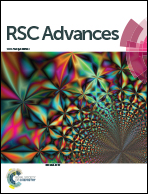Microphase separation/crosslinking competition-based ternary microstructure evolution of poly(ether-b-amide)†
Abstract
The temperature dependence of the rheological properties of poly(ether-b-amide) (PEBA) segmented copolymer under oscillatory shear flow has been investigated. The magnitude of the dynamic storage modulus is affected by the physical microphase separation and irreversible crosslinking network, with the latter spontaneously forming between the polyamide segments and becoming the dominant factor in determining the microstructural evolution at temperatures well above the melting point of PEBA. From the rheological results, the initial temperature of the rheological properties dominated by the microphase separation  and crosslinking (Tcross) structures were determined, respectively. Based on the two obtained temperatures, the microstructure evolution upon the heating can be separated into the ternary microstructure domains: homogenous (temperature below
and crosslinking (Tcross) structures were determined, respectively. Based on the two obtained temperatures, the microstructure evolution upon the heating can be separated into the ternary microstructure domains: homogenous (temperature below  ), microphase separation dominating (between
), microphase separation dominating (between  and Tcross), and crosslinking dominating domains (above Tcross). When the PEBA is heated to above Tcross, the content of crosslinking network increases with time and temperature, leading to an irreversible and non-negligible influence on the rheological, crystallization, and mechanical properties. A more pronounced strain-hardening phenomenon during the uniaxial stretching is observed for the sample with a higher content of crosslinking network.
and Tcross), and crosslinking dominating domains (above Tcross). When the PEBA is heated to above Tcross, the content of crosslinking network increases with time and temperature, leading to an irreversible and non-negligible influence on the rheological, crystallization, and mechanical properties. A more pronounced strain-hardening phenomenon during the uniaxial stretching is observed for the sample with a higher content of crosslinking network.



 Please wait while we load your content...
Please wait while we load your content...